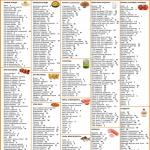A man is greeted by his clothes, a man by his shirt, and certainly a shirt by his collar.
Collar located so close to the face that it will tell you too much about its owner.
I hope that my view on the topic “ how to sew a shirt collar on a stand.” will be interesting.
I will try to consider not only the sewing algorithm, but also focus on tricks and tricks that will make the shirt collar more beautiful. Of course, not only knowledge plays a role, but also skill.
Every cook cooks borscht in his own way, and for everyone it turns out delicious and special. Either you can or you can’t.
Let's not let our men down, let's sew a real shirt self made. The full cycle of sewing a shirt is in the article
At the stage of sewing in the collar, the following must be completed: shoulder seams, placket.
Classic stand-up collar for men's shirts. How to sew beautifully: secrets and tricks.
Cut out the collarperfectly symmetrical.
From shirt fabric:
2 collar parts, allowances 0.8-1 cm
2 stand parts, allowances 0.8-1 cm
from good collar thermal dublerin:
1 stand piece, without allowances
1 collar piece, without allowances.
The collar padding is quite dense and will hold the shape of the collar perfectly. And the form is the main thing.
Focus on tricks.
1. Do not make the height of the shirt collar too high: 1-1.5 cm above the stand is quite enough. The length of the stand should be equal to the length of the neck - measure in the shirt along the imaginary line of sewing in the collar!

Duplicate collar details :
top collar and outer stand.
That is, we strengthen with an adhesive gasket those parts that are “on top”, in plain sight.
Why? Because:
a) collar thermal dublerin clearly models the shape, b) allowances are not printed on external parts.
Although in the recommendations of the “shirt makers” (and in GOSTs!) the internal stand is glued, but I do it my own way. If one of the masters leaves in the comments the answer to the question “why internal?”, I will be very grateful. Not because “it’s customary,” but precisely “why.” Your advice is in our piggy bank!
Don't have a good collar understudy? Take the non-woven fabric and duplicate both parts of the posts and collars. This is what I do in light women's blouses.
You might find this article about duplication rules, based on personal experience and an interview with the manager of the Hensel company.
Align and pin the collar pieces with right sides facing inward.
Here's the trick:
2. chip slightly at the bend in the corners. The upper collar is thus 1-2 mm larger than the lower one, which will allow for a beautiful roll of the seam.

Sew a collar.
There is not one, but three tricks:
3. Set the stitch small, approximately 1.5 mm. Or stitch with a regular stitch, and when approaching the corner, reduce
4. Sew to the corner and then make one cross stitch. Only one. Unfold and continue stitching the collar.
Oddly enough, one short cross stitch will create a sharper angle. Why? Due to seam allowances. No matter how we cut them off before turning them inside out, the excess fabric will still create a thickening in the corner.




5. do not lay the line precisely along the border of the doubler, but at a distance of 1 -1.5 mm.
And you will have a beautiful seam roll to the side of the lower collar.

Cut seam allowances and trim seam allowances
– in the corner, up to 1 mm from the line. Trim the allowances step by step along the flap (long side) of the collar. This is standard operation.
Turn the collar inside out and sweep it out.
I do not use sharp objects, I do not pull out the corner with a thread and a needle. I’m scared: the shirt fabrics are too loose—I don’t risk tearing a lovingly made corner.


Check the symmetry of the ends of the collar.
I do not like? Fix it!



Collar stitching.
For this purpose, a foot with a limiter is indispensable, and the stitch width can be adjusted by the orientation of the needle. Nowadays there are modern generation machines that allow the needle position to be moved left and right.
Placket, cuffs and collar – pay attention to the stitching!
6. All stitching on the shirt should be done using a stitch of the same length and at the same distance from the edge.



Sew the collar stand in two stages.
1) prepare the outer one like this: fold the seam allowance and topstitch (the foot from the previous operation).


I mark the middle of the pieces with a hot iron and chip away from the middle.
Pin the outer stand to the bottom collar (face + face). Sew clearly along the border between the collar and the stand.
Why is this intermediate operation needed:
It is easy to control the stitching boundaries and compare symmetry easily. But we need to compare.


2) Pin the inner stand and sew a beautiful “stand + collar” knot along the entire length.
7. Chip slightly “at the bend”: in finished form The collar stand will acquire a beautiful bend, following the shape of the neck.
On the wrong side of the inner part, mark with a marker (with chalk) the border of the stitching of the stand - clearly along the edge of the outer stand.



8. Check that the length of the stand clearly matches the length of the neck of the shirt.
If you cut out and sewed the collar correctly, the sizes will match. And if not...surprise! - We will redo the collar.
If the stand is wider than the neck, then definitely reduce it.
If the neck is wider than the stand, then 0.5 cm can still be added. But no more than half a centimeter. No more.
There is a second option for sewing the collar stand (no photo), in which the stand is first aligned with the neckline, and then the bend of the stand is stitched - exactly to the edge of the bar. I will try to do another master class on collar stand, a little later, with a philosophy on the topic “what is best.” The answer is not clear-cut.
Sew the stand to the shirt.
Here, be careful what you pin on what (smile).
I sometimes get confused because “you can’t just sew on a collar the first time” (c)
Correctly like this:
Inner stand (face) + shirt (wrong side).
Check again: The stand is placed right side on the back of the shirt.
The seam allowance should end up on the right side of the shirt.
Attention to detail:
9. Make a point hand tack using thread to match the shirt, aligning the stand with the edge of the placket. The layers will not move when stitched.
10. Cut the neck allowances, not reaching the seam 2-3 mm. This is important so that the collar fits beautifully.
Sew the inner collar of the shirt.
11. Place the stitch 1 mm to the left of the border marked with a marker. The inner stand will be narrower and the stitching seam will “hide” under the outer stand.
Iron the seam.



Carefully tuck seam allowances inside.
Sew on the outer stand.
Baste or pin, do as you like. At this stage, if the previous ones were completed perfectly, there should be no surprises.
But although not, it’s better to sweep it. Your fingers can feel the boundaries of the seams well, and running stitches will securely secure the position of the outer post.
Sew along the front side of the stand. We start stitching from the middle of the neckline and, without interrupting the stitching, stitch along the entire perimeter of the stand.
The seam is beautiful on both sides of the collar and runs along the edge or at the same distance from the edge of the inner stand.


Useful trick:
12. Insert a needle with a long thread into the corner of the stand - this will help guide the sewing in “strategically important places” where the stitching can “slip” on the thickenings. Just gently pull the tail of the thread to advance the piece.
Any turn-down collar cut from upper and lower parts. If the fastener of the product is located in the front, then the collar is represented by one solid part, and its ends are connected at the place of the cut for the fastener.
The turn-down collar on products with a fastener on the back consists of 2 parts - right and left, which are joined at one end in the center of the front neckline, and at the other end at the slit for the zipper.
- Attach the seal to the wrong sides of the top 2 collar pieces, right sides together. Line up the cut edges and pin all the top pieces to the loose bottom pieces. Baste parts of the collar, but leave the edges of the neckline free, remove the pins.
- Run the machine along the outer edges of all collar pieces. If the fabric is thin, then set the stitching to small stitches. When strengthening each side of the corner, step back 1.5 cm from the top. If the fabric is a little thicker, then make a few stitches across the tops of the corners to blunt them a little. Remove the basting.

- Trim seam allowances. At the bends, make “V” shaped cuts into them around the bends (top). On 2 sides of each corner, bevel the seam allowances diagonally and cut off the corners. If the stitching gathers, smooth out the collar seam as you move the presser foot.

- Using a sleeve ironing board, press the seam, opening the seam allowances with the tip of the iron. For rounded sections of the collar, it is better to use a curved section of the board. The seam allowances should be pressed towards the bottom of the collar, and remember to press the stitching seam again section by section.

- Machine stitch along the collar seam, working from the right side of the bottom collar piece, taking the seam allowance close to the seam line. If, due to the shape of the collar, you cannot sew the entire seam, then sew while you can.

- Turn the collar pieces right side out. Turn out the corners using a needle with a thread folded in half and a knot tied at the end, first passing the needle inside and then pulling it back out.

- Try using your finger to roll the seam a little, moving it towards the bottom piece. Press the offset seam edge by running the tip of the iron along the seam, section by section. Then iron the collar from the front side through the fabric to prevent unwanted shine from appearing.


If ironing does not hold the seam offset towards the bottom piece, pin the collar pieces along the edge of the neckline. Baste along the outer edge. Remove the basting from the finished product.
Most easy way sew on a turn-down flat collar - place it between the garment and the inner hem and stitch together. A turn-down flat collar made of one or two parts is sewn in the same way, except that the collar from the one-piece part is turned with its ends toward the middle of the front.
- Before you start sewing on the collar, sew down the shoulder seams and sew the darts running towards the neck line. Attach the zipper. Mark the middle of the front with a pin.

- For a collar consisting of 2 parts, baste along the neck line, connecting 2 layers of fabric. At the junction of the front ends of each collar piece, overlap them when basting.

- The collar must be pinned to the front side of the product. The top of the collar piece should be at the top, the raw edges should be aligned, and the markings should be aligned. Place a point where the collar pieces intersect with a pin and baste the collar. Remove the pins.

- Cut out the inner facing and pin it to the top part of the collar along the neckline, right side inward. Align the edges of the neckline. Leave 1/2 inch ends on each side of the zipper cut. Baste. Machine stitch along the neckline through all layers of fabric.

- Remove the basting. Trim the seam allowances, leaving the seam allowance on the product side a little wider. Trim the corners of the facing seam allowances diagonally at the cut area at the shoulder seams and at the back. Make “V” shaped cuts along the curves, making them more often on the more curved areas.
Collars have been at the peak of their popularity for several seasons in a row and are not going to lose their positions. By purchasing a ready-made dress or blouse with a collar or choosing a removable collar to complete the look of any style, you will not go wrong and will find yourself in the center of attention.
Fashion designers from famous and not so famous famous brands, generously decorate their products with various collars. But personally, I am with both hands for removable collars, which can be used to refresh an old, most beloved and perfectly fitting blouse, which can be worn with different dresses or even sweaters depending on the mood, and ideally, I am “for” having a whole army of removable collars, the most different - delicate lace or satin, embroidered with beads or natural stones, decorated with rivets, spikes or chains...

Anyone can make a decorative removable collar. First you need to decide on the desired shape of the collar and its style. Next, we decide on the collar clasp - ribbon, decorative cords, chains, buttons.... Have you decided? Let's move on - below are the patterns of the most popular collars, select the one you need and transfer the pattern to paper in the size you need.

Then we cut out the paper pattern and transfer the contours to the fabric. Any fabric for collars is suitable, but remember that parts for a collar made of thin fabrics must first be placed on non-woven fabric and a seam allowance must be added when cutting. It is better to cut out collars with full embroidery with beads and beads from felt, artificial leather or non-woven fabric ironed in 4-6 layers. If you are planning to make, for example, a satin collar with partial embroidery with beads, then you need to place the front part of the collar on several layers of non-woven fabric, sew on the beads, and only after that sew on the wrong side of the collar.

Below is a simple tutorial on how to make a removable leather collar. Two wide parts and two narrower parts are cut out of leather. Holes are made along the edges of the wide parts, then the backside of the narrow parts is coated with a thin layer of glue and glued to the backside of the wide parts. The front collar pieces are assembled using satin ribbon, pieces of chain with a lock are attached to the edges of the collar.

All photographs and patterns were found on the Internet, all author's logos were preserved. I propose to consider photographs and patterns without logos as folk ones. If you know the name of the author of a photograph or pattern without a signature, write in the comments and in the near future I will definitely sign his work.
You can update your wardrobe different ways. This time the reader will be presented with 15 amazing ideas on how to do this for mere pennies.
1. Bright clutch

A bright and stylish clutch that can be made from a piece of polyvinyl chloride, most often used to make napkins for table settings, good glue and a thin black belt.
2. Children's cape

A stylish children's cape that you can easily make with your own hands from two small pieces of fleece and a satin ribbon. You just need to put two pieces of fabric together, make holes in them and put a ribbon through them. The edges of the fabric can be finished sewing machine or for lack of skills using fabric adhesive tape.
3. Decorative scarf-snood

Unnecessary knitted T-shirt or a skirt can be turned into a stylish snood scarf that is still relevant this season, which will be a wonderful addition to your autumn look..
4. Skirt

Anyone who knows how to sew buttons can make such a skirt in a way that does not require any special skills to create it. To implement this idea you will need thick fabric, scissors and big button.
5. Jacket with a slit

If you have a jacket in your closet that has been collecting dust for several seasons without use, you can try to do a similar trick with it. Armed with a ruler and a textile marker, draw a triangle on the back of the pullover so that its tip matches the collar. Cut out, secure the edges with fabric tape, and sew Velcro or a hook onto the collar. The trendy jacket with a slit on the back is ready!
6. Sheepskin vest

All you need to create this stylish vest is a rectangular piece of dubbing and fittings. Using scissors, make neat cuts for the arms, sew the purchased accessories on the back and enjoy a cozy and unique item made with your own hands.
7. Sweater with patches

You can update an old, boring sweater with two curly patches on the elbows. Simply buy a small piece of knit or sequin fabric, cut two identical patches from it, and use a thread and needle to sew them onto the sweater.
8. Sweater with lace

A small piece of lace will help transform a sweater that is far from new. Carefully sew openwork fabric from the inside along the bottom seam of the item, and the dull sweater will turn into a charming and romantic product.
9. Stylish denim jacket

A wide lace insert will turn an ordinary denim jacket into a stylish and feminine piece of autumn wardrobe.
10. Wool decoration

You can make a charming necklace from leftover wool yarn and accessories. This decoration can be sewn to the collar knitted sweater or wear with any other outfit as an independent accessory.
11. Sweater with an original collar

Small curly cuts will help to update and add charm to an old knitted sweater. The main thing in this matter is accuracy and imagination.
12. Petals

Petals cut from thick fabric different colors, and sewn onto a plain sweater will help turn an absolutely inconspicuous item into a designer item.
13. Cardigan with pearls

Pearl-like beads, which can be bought in craft stores, are an excellent material for decorating clothes. These beads can be used to decorate the collar, shoulders or the entire cardigan to give the product a truly luxurious and stylish look.
14. Jeans with leopard inserts

You can update old, but no less favorite jeans with the help of leopard print inserts. Pieces of fabric with an animal print that is trendy this fall will help give jeans a new stylish look and disguise various signs of wear, such as scuffs, holes and stains.
15. Charming collar

Update and improve appearance Shirts and blouses will benefit from a simple collar decor. Office blouses can be embroidered with beads or beads, and the collars of everyday shirts can be decorated with spikes, rivets or chains.
Continuing the topic, I would like to present some more with my own hands.
In contact with
13 fashionable collars that you can make by hand.
It all started with Miu Miu, who were the first to suggest wearing collars that are removable or different from the rest of the outfit. This trend has become incredibly popular lately. Perhaps the reason lies in the freshness of the idea or in the breadth of choice and self-expression, one thing is clear - this accessory, simple in its essence, is an exceptional and original decoration. Of course, you can look for a similar accessory in any of the brand boutiques or order it in an online store.

Or you can show your creativity and start making your own collar. We'll teach you how.
Easily

The easiest way is to rip off the collar of an unnecessary shirt and sew beads, chains, cute braided threads and much more onto it. At your discretion.

It’s even easier to rip off the collar and sew it on a shirt of a different color. The same can be done with the cuffs.

Another equally simple way is to apply a beautiful applique to a torn or cut collar.



A very gentle and cute option for decorating a collar:

Here, as you understand, you will need a shirt pastel shade(or such that it goes well with pearls), artificial pearls (or white beads), thread, scissors.

Fine
A collar like the one in the photo below does not require much effort.

You will need a plain shirt, a brooch, thread with a needle and scissors.


It may seem that the next collar will require a lot of effort, time and patience...

... but it's actually not that complicated. You will need a collar, a ribbon with beads/sequins/pearls (these are usually sold in sewing stores) and a button to match the jewelry.

wardrobewanders.blogspot.com
You don't need any special knowledge to create your next collar. sewing. Just a little patience and a good eye. Also: a shirt, a feather (or something sharp for making holes) and decorative screw rivets.



To design the next collar you will need a little more time and patience.

Other than that, you'll need: a button-down shirt. Not necessarily the same shade. Decorative metal studded rivets. Pliers.




An option for the brave in spirit. What do you think is this stuck on the collar?

Basically, this is what's left of several optical discs.
What you will need: an unnecessary shirt (more precisely, the collar from it), a couple of old disks (the quantity depends on how much fabric you want to cover with fragments), scissors and glue.
First, cut off the collar. Then cut the discs into the desired pieces, being careful to hold the discs so that there are no marks left on them. Cover the collar with the resulting pieces the way you want.


Difficult
In order to create collars from the level marked “difficult”, you, at a minimum, need to have titanic patience, diligence and some sewing skills. Or a bunch of source material on which you can train.
So, the first collar in this category is a luxurious, pearl-golden one.

It needs to be done from scratch, that is, the option of cutting off the collar from an unnecessary shirt will not work in this case. What you will need: the fabric from which you will sew the collar, a hard surface, pearl beads, golden bugles, a pattern (which can be downloaded from here).
What to do.
1. Print out the pattern.
2. Cut out two patterns using it. They are different sizes.

3. Iron the sides of your patterns that will be inside after you sew them together.
4. Fold both parts of the future collar with the outer sides facing each other. Place the smaller part so that there is a small indentation on each side. Secure everything with needles. For convenience, you can swipe back side mostly dotted. Sew both parts to each other using a sewing machine. Leave a small hole so that the collar can be turned out.



5. Trim the edges and turn the collar right side out. You can do this using a knitting needle.


6. Sew the hole by hand.

7. It's time to decorate the collar. To begin, trim its edges with pearl beads in 2 rows.





